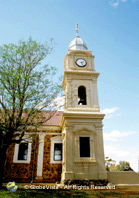
Many years ago, while researching content for West Australian Vista, I came across an article briefly mentioning a ghost that haunted a clock tower at New Norcia. It claimed the apparition appears as a nun dressed in a blue habit. She can sometimes be seen wandering around the clock tower of the monastery just as the bell tolls midnight.
I wasn’t at all surprised that there would be a ghost in this little monastic town. New Norcia, being in the middle of nowhere and having such a checkered past, makes for the perfect setting.
So who could this ghost be?
So Who Is The Blue Nun?
From 1904 to 1974 the Benedictine Missionary Sisters from Spain ran St Joseph’s Native School and Orphanage in New Norcia. Many of the Sisters did not speak English, nor did they wear blue habits. This was not at all helpful.
I originally thought that the “nun” in question may not be in any records, especially if she had met some grisly end. A clock tower and ghost usually equate to suicide. So I wasn’t sure if there would be any mention.
I made a list of all the Sisters who were buried at the New Norcia cemetery and began a name search.
One Sister caught my attention. Her name? Sister Maria Harispe.
Sister Maria Harispe
Twenty-six-year-old Sister Maria Harispe arrived in New Norcia in 1907 from Paraguay. One can only imagine what went through her mind when she first set eyes on the harsh, dry landscape. There were very few Sisters at New Norcia at this time and it was very much a peasant lifestyle. Sister Maria’s role was to teach the local Aboriginals the way of the Lord.
From letters and correspondences, we know that Sister Maria immersed herself with the Aborigines. In fact, she grew to love them like family. However, after 9 months working at St Joseph’s, it looked as though her role was being threatened.
In 1908 Sister Maria Harispe sent a handwritten letter, in Spanish, to the secretary of New Norcia’s Abbot Torres pleading to continue her work.
In the letter, she stated 4 reasons. Firstly she wanted to be part of the house founded in Australia for “natives”. Secondly, because she had promised God her sacrifice to him was to live away from the world and her family. Thirdly, she had a compassionate love for the Aboriginal people. And lastly, because she wanted to sacrifice her life for them and die amongst them.
She also requested that, though she continued to be identified as a religious sister, she wanted to be regarded as a “native” in material terms. She also stated she wanted to continue to wear a habit but it was to be made of sackcloth. Well, that could explain the blue habit. A light colour reflecting in the moonlight just might appear blue? Straw clutching?
Her letter must have worked as her request to stay and run the school was approved. She is noted as being the foundress of St Joseph’s.
Sister Maria spent the next 17 years living and teaching amongst the Aborigines at New Norcia. She was greatly loved in the community.
In 1925 Sister Maria became gravely ill with cancer. The community hoped and prayed for a miracle but sadly in November, the much-loved Sister Maria passed away, 10 minutes after receiving Holy Communion. The church bells were rung to announce her passing. When the aboriginals heard the bells toll they all gather around her to pray. Many felt as though they had become orphans. It was noted: ‘She was loved by everyone, as she was a mother to everyone. So we were without a mother’
It isn’t hard to imagine that the blue ghost is Sister Maria Harispe wandering around the clock tower at midnight keeping an eye on the community she loved and cherished.
References: Evangelists of Empire ? Missionaries in Colonial History : edited by Amanda Barry, Joanna Cruikshank, Andrew Brown May and Patricia Grimshaw. History Conference and Seminar 18, School of Historical Studies, The University of Melbourne.
“That There Was Love In This Home”: The Benedictine Missionary Sisters At New Norcia by Katherine Massam
http://www.ozburials.com/CemsWA/Victoria%20Plains/newnorcia.htm
